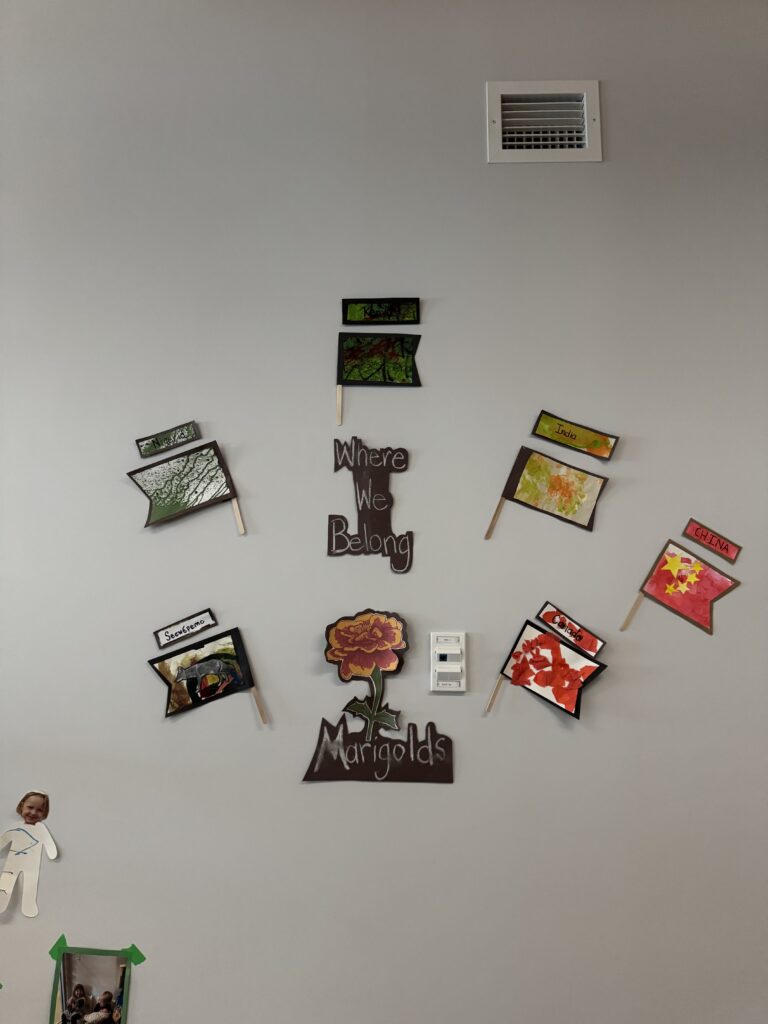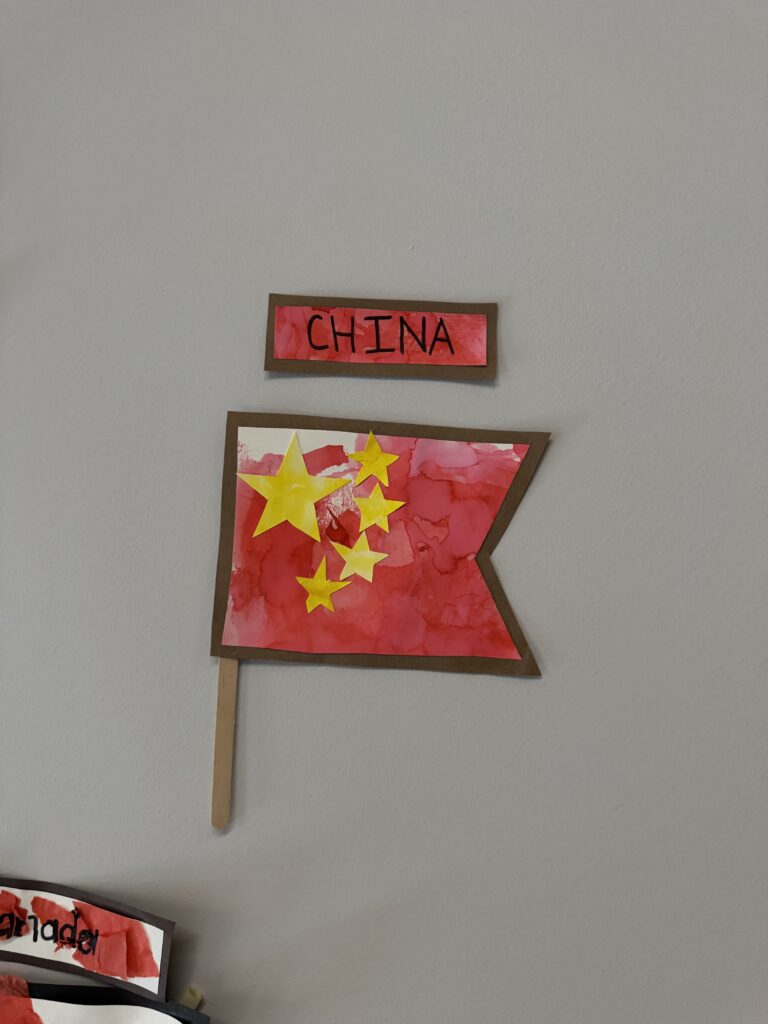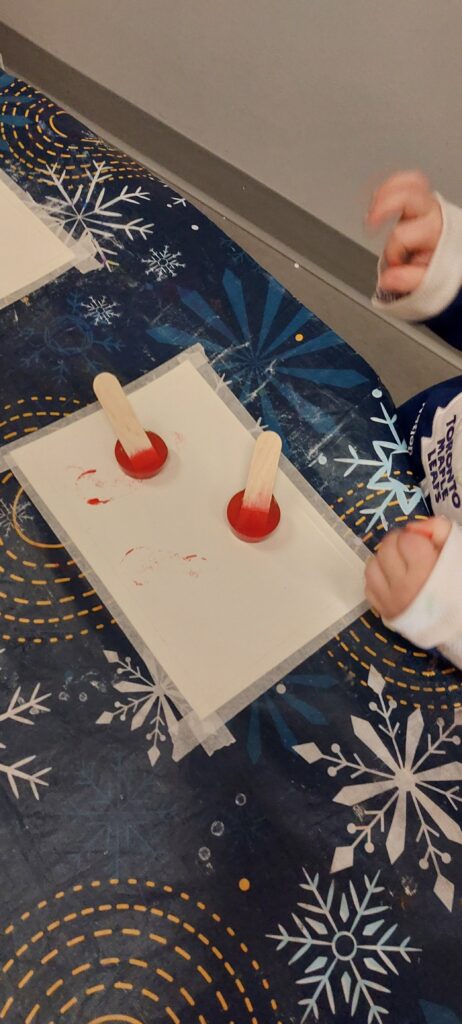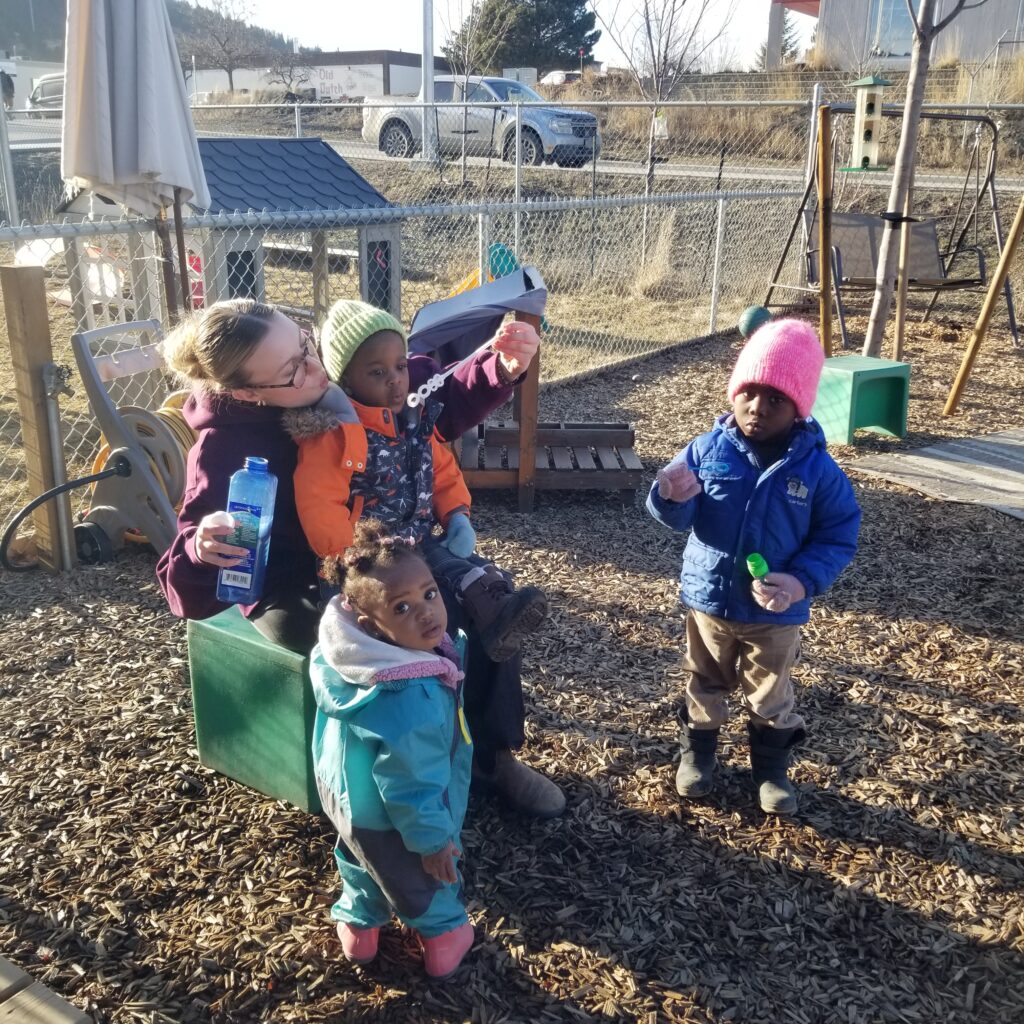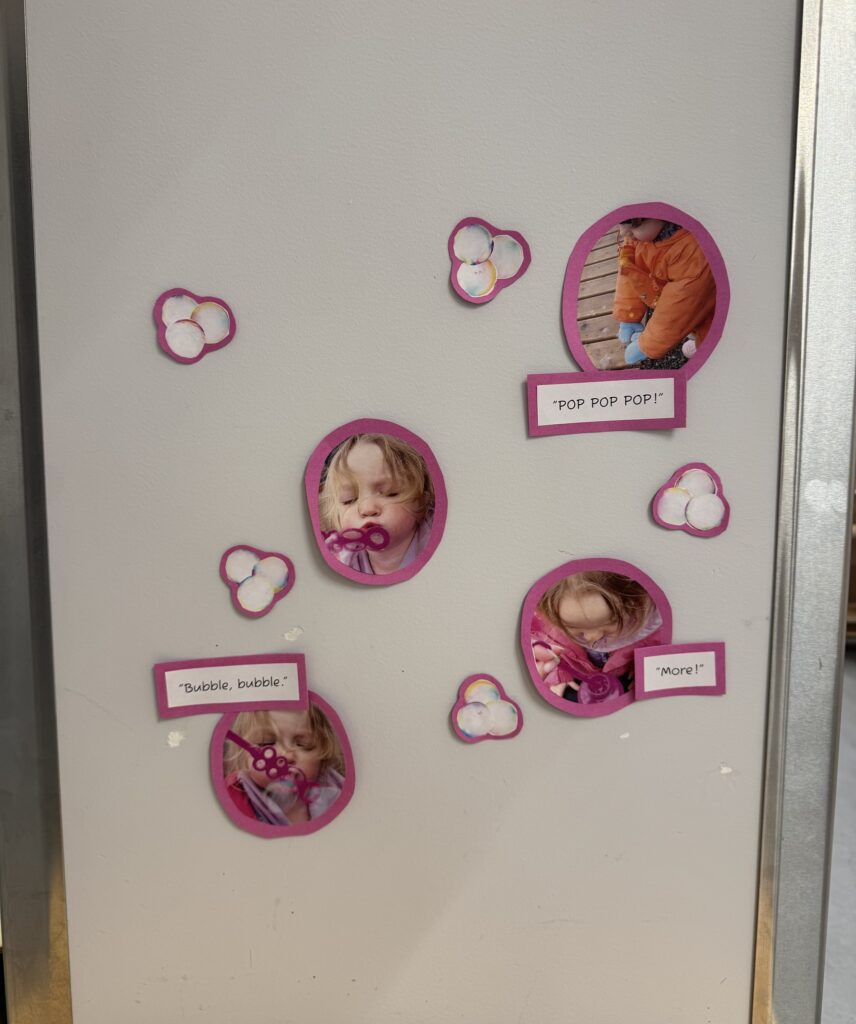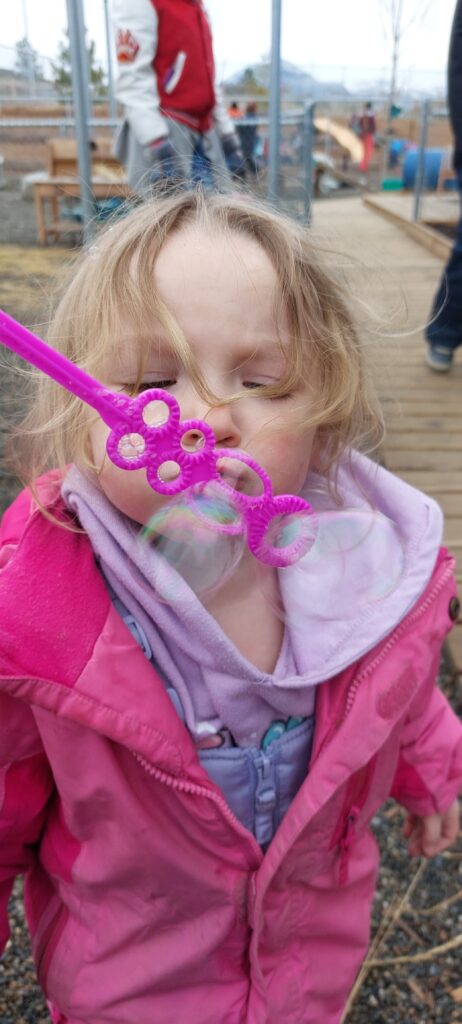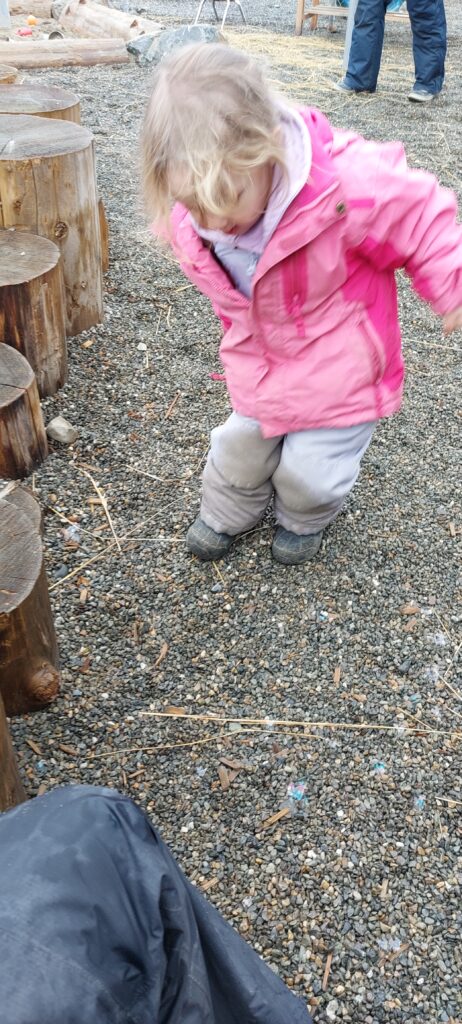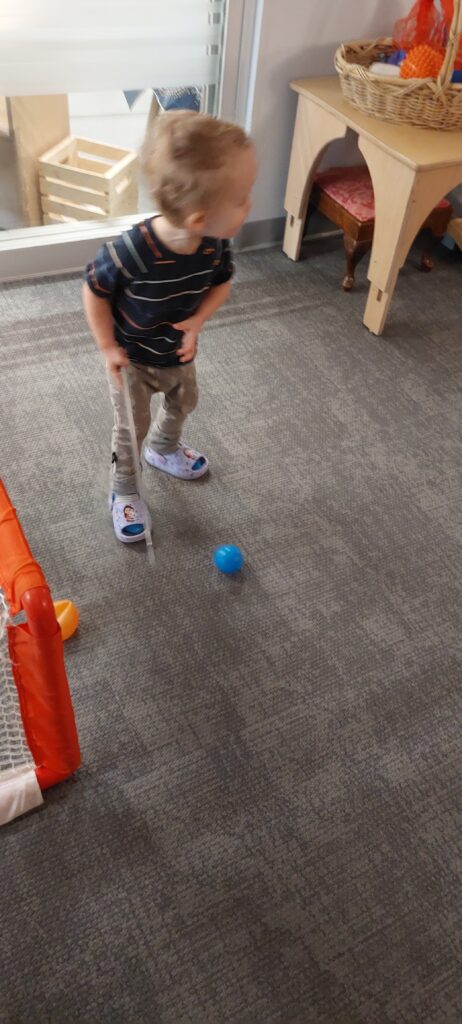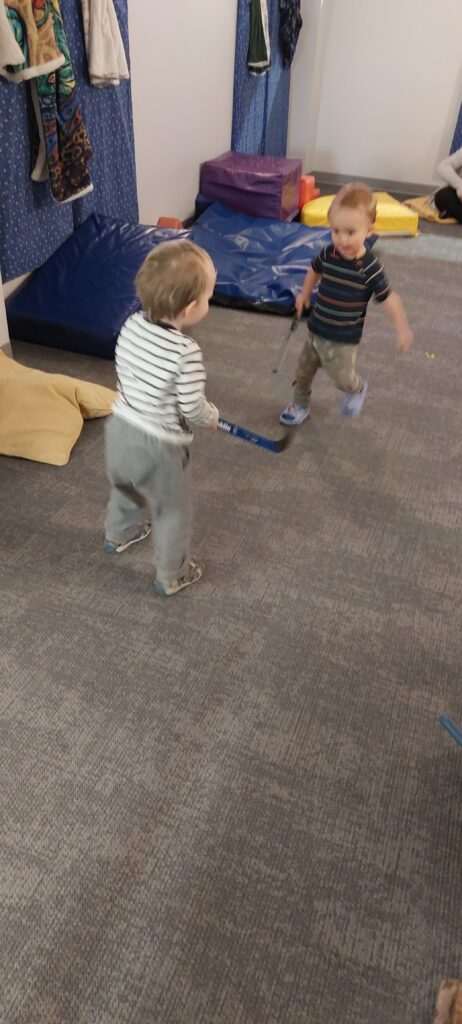The theme for my happenings is creating community and togetherness. This is important to me as children and educators spend so many hours together, it is vital to create a community of well-being, belonging, and an overall joy of being together with one another.
Happenings 1 – Welcome, Justin!
As we continue to welcome a new child to the Marigold room, I made the Chinese flag to put on the wall with the others to represent this child and their family. My intention behind the choices I made was to involve the children in welcoming our newest member in hopes of engaging in conversation surrounding him.
I chose to offer ice block and plastic bag painting with different tools to give the children variety, but mainly because I have never done these in my work with children before, I wanted to try them.
BC Early Learning Framework Connection:
In the BC Early Learning Framework, section three, living and learning together, I thought alongside the well-being and belonging section. My connection for this happening is the culture and worldviews section, where this quote stood out to me. “All children’s cultures are welcomed, valued, and woven into programs in ways that are transformative” (BC ELF, 2012, pg. 67). I see this pathway in the life of our room in different ways. First and foremost, this wall in our room is where the flags are. Second, upon entering our room, we labeled all the languages that are spoken or have been spoken in our room. I think this is a beautiful way to honor the diversity that lives within the Marigold room.
When new life enters the classroom, children and educators are essentially learning to live and learn well with one another and this new child and family. I feel like that process is easier when the parents and even the child feel welcome and see themselves represented in the room, even before they’ve fully immersed themselves in the program. Therefore, I feel like representing any family with their flag is such a small act of respect made towards each family and is a gateway to building a relationship with them.
Reflective questions:
“In what ways are community members invited and welcomed into my program to enhance cross-generational, cultural, and relational learning?” (BC ELF, 2012, pg. 70).
Community members, such as families, are very welcome in the Marigold Room. There is a lot of representation such as photos of each parent, child, and sometimes pets, printed, laminated, and on the floor for children to interact with throughout the day. On the wall, there are photos from a tea party that was hosted where, from what I understand, parents were welcome to come have tea, talk, and visit with the others who share this space with their child. I continue to see responsive and respectful interactions between parents and educators. These deep relationships create a positive learning environment where relational learning and a supportive, collaborative atmosphere is had.
“How are children’s cultures welcomed, valued, and woven into my setting in ways that are transformative?” (BC ELF, 2012, pg. 70).
As mentioned, children’s and families’ cultures are welcomed and valued in the Marigolds room. One way my room does this is by representing the families by their flags of where they’re from. Another way we do this is by language; different languages are spoken and understood amongst some children in this room. Therefore, we weave their language into our work by speaking phrases and words in the language they speak at home. This shows respect towards the children, as we are showing that they are not the only ones who have to change and learn; however, we can meet them halfway.
What will I do next in response to their engagement?:
As the flag is completed and up on the wall, the children aren’t truly able to have any further engagement with the physical piece of this happening. However, this bigger picture that extends well beyond a flag is the new child in our room. Therefore, going forward, I am going to try and nourish a connection between the existing children in the Marigolds and the new life that is entering. I will do this by integrating Justin into things like our snack and lunch table as he grows more comfortable in our room. Bringing him up in conversation with the children may help, and also further bringing his culture into our room may help to engage the children and educators in co-creating and navigating a relationship with him and his family.
Photos:
Happening 2 – Bubbles!
One thing I notice that is a continual happening, and interest within the Marigold room is a love for bubbles among the children. Bubbles are asked for, whether we are inside or outside. I find that doing bubbles, especially outside allows for connection with different children, from different rooms. Often I will be blowing bubbles and children from the Poppies room come over and join as well as the children from my room. Another instance where connection flourished was when the bubbles blew over into the Seedling’s yard, which interested a couple of the children and they came and stood by the fence to join us. As I was blowing the bubbles they were getting caught and resting on the fence, which they seemed to enjoy as they popped them off the fence. I continued to blow bubbles as I watched the children on each side of the fence connect and laugh together over the joy of the bubbles.
BC Early Learning Framework Connection:
For this happening I chose the, engaging with others, materials, and the world pathway. “Children construct meaning as they engage with materials, other children and adults, the environment, the community, and the world.” (BC ELF, 2012, pg. 75). I found this pathway come to life within the children as I saw them engaging with each other, even with physical barriers in between them. I saw them engaging with the material, which was the bubbles. Depending on the amount of children I have, I often let them blow the bubbles themselves as this allows for a different interaction between them and the material. The other most common interactions are popping and jumping on the bubbles. Last, their interaction with me, I always find meaningful connection and interaction with the children through blowing bubbles, especially when this is happening one-on-one.
Reflective Questions:
“What materials invite experimentation, problem-solving, or intrigue? Consider how materials are presented. How does this limit or invite experimentation and investigation?” (BC ELF, 2012, pg. 77).
The way that bubbles are currently presented does have limitations. As they are not accessible unless asked for, I wonder how I can present bubbles in a way that makes them a continual material available, in a way that can be left out and returned to periodically as the children wish. Moving forward I wonder about the possibilities this curiosity would have if I put bubble liquid in a water table with the sticks available so it could be more collaborative and child-led.
“What limits are placed on how children can engage with materials? Who decides the limits? Why are those limits in place?” (BC ELF, 2012, pg. 77).
Certain limits are placed when we use bubbles, especially when they have their own with a small container. For example, we only fill up their container once and then once that container is empty they’re all done. This limit is set into place to preserve the amount of bubbles we go through, especially since often a child will bend over and accidentally pour them out. I notice that they can often get sad when their bubble juice is all gone and thinking forward I wonder how I can avoid this occurrence. Once their container is empty and if they are still wanting more, I offer for them to blow big bubbles with me. Whenever I fill their container up I always try to emphasize keeping their container upright to avoid pouring it all out. Another idea I have is homemade bubbles, to reduce the amount of bubbles we have to purchase. I wonder if a homemade recipe would work as well.
What will I do next in response to their engagement?:
Something I have already done to further their engagement is putting up documentation on the wall. I did this to further bring the idea of bubbles, as not just something that can be done outside, but something that can be brought inside as well. I hope by putting this up on the way we can think together on how we could bring this curiosity inside in different ways, as well as outside.
Photos:
Happening three – Hockey!
I wanted to continue my happenings with the theme of creating community and togetherness therefore I chose hockey. As with the bubbles, hockey is a big interest in the Marigold room. Hockey is something that the children are interested in whether it be outdoors or indoors. We often convert the nap/jumping room into a hockey arena for the children. Certain children like Rufus and Rowan will come to daycare wearing their hockey jerseys or sweaters for days on end. This interest allows for relationships, especially between these two, to flourish. Hockey allows the children to get out some of their “big” energy as they run around shooting, passing, and scoring. When they score they will often yell “Score!!” and continue to do this over and over again. I notice when they are playing hockey they will work and live well with each other, building community while being together. It also builds connection and awareness of their bodies, as everyone is running around they have to be careful to keep everyone’s body safe.
BC Early Learning Framework Connection:
I’ve chosen the well-being and belonging section of the ELF to connect to this happening. I further looked at the interest and inquiries pathway, “Children can engage with their own ideas, theories, and inquiries in ways that are meaningful to them” (BC ELF, 2012, pg. 68). As hockey is an interest within the room, among many children, I watch as they engage in different ways with the materials, the hockey nets, sticks and pucks. And how they collaborate and engage with each other through this mutual interest. This is something that changes as well, often they will play together sharing one ball running around shooting, other times each child may have their own ball that they play with and perhaps they don’t collaborate but they share the space and the nets.
Reflective questions:
“Can children investigate interests and passions over days? Weeks? Months?”
I believe that children are able to engage with this specific interest and passion over long periods of time, the hockey nets are always in the nap room and accessible to the children, same with the sticks. I do wonder however if this is something that could stay out and be something that they could leave and come back to as they want. I think that once the weather gets warmer the nets are also something that could be left outside for various days, as the nap room has to be converted every day for naptime.
“How do adult expectations shape/limit how children engage with materials?”
I think that adult expectations and knowledge does shape the way children engage with this interest. I find that sometimes when the children ask for the hockey nets down from their storage spot I will sometimes place them in the room for them, often in a traditional way or setup of a hockey arena. I have caught myself doing this and wondered why I placed them for them, maybe they didn’t want them there, or they had a different vision for themselves. If this is the case the children often move them to where they want or ask me to, however, I have stopped to think why I did that in the first place, why not let the children take the lead in the first place?
What will I do in response to their engagement?:
Something I would like to do in response to their interest and engagement is sit, watch, and document the happenings of hockey, writing down their dialogue and possibly taking pictures. Then, I can print and display this work on the walls in the nap room, where most of the hockey is done. I would be interested to see how this changes hockey and how they would engage in seeing themselves play hockey in a photo while also physically playing it.
Photos:
